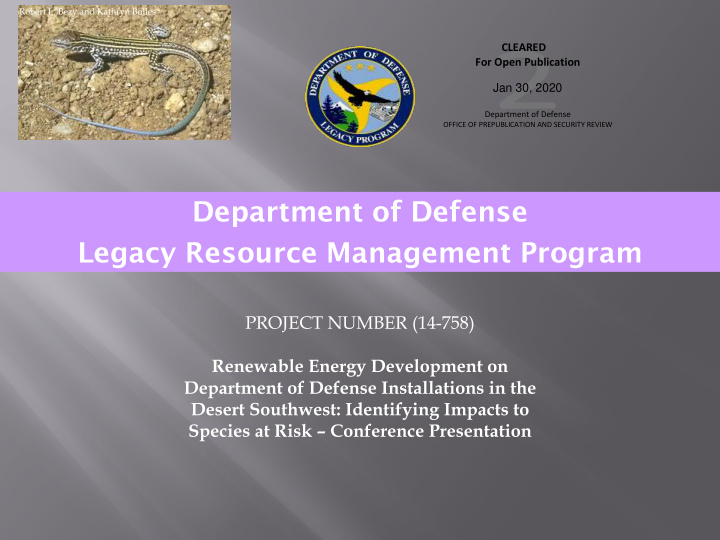



~ Robert L. Bezy and Kathryn Bolles CLEARED For Open Publication Jan 30, 2020 . . ~-- · . . Department of Defense , ., OFFICE OF PREPUBLICATION AND SECURITY REVIEW !\M.A • . , ' 11'{,Q" , _._,._. U Department of Defense Legacy Resource Management Program PROJECT NUMBER (14-758) Renewable Energy Development on Department of Defense Installations in the Desert Southwest: Identifying Impacts to Species at Risk – Conference Presentation
Martin D. Piorkowski, Joel M. Diamond, PhD, R. Nathan Gwinn, and Haley Nelson Arizona Game and Fish Department, Wildlife Contracts Branch 5000 W. Carefree Highway Phoenix, Arizona 85086
High Small Vertebrate Biodiversity Mojave and Sonoran Deserts Net Zero Energy Concept RB Forbes Solar Development Mission Readiness M Piorkowski
1. Quantify differences in reptile and small mammal diversity and abundance between solar development sites and un-impacted sites on DoD installations 2. Identify the spatial extent of solar development impacts on wildlife communities with application to Species at Risk 3. Evaluate the mitigation value of “soft-footprint” solar development when compared to standard “hard-footprint” development
Davis Monthan AFB Yuma Proving Ground Edwards AFB - ...... , /' • 1( • .. - _, , t 0 ... :IOO ,., -
~ Three strata Treatment Edge M Piorkowski Control Two Super transects Solar facility physical Nested sampling - - - - f ~_p~ ~t ---- 1 I 1 Treatmeot i"- {Il] 1 Mammal trapping Supe r Transect A 1 1 Super Tr a nsect B mn mn mn mn' Reptile trapping H -- 1- llill I IOOm l , llW llW llWj rrtn ,. , Three footprint y : UilJ : y intensities Grid 1 Grid 3 Grid4 Grids Edge l __ _ _ _ ________ 1 C o n trol *Not shown to sca le
Pool data between two super-transects to generate species diversity indices, species richness, and relative abundance estimates zyxwvutsrqponmlkjihgfedcbaZYXWVUTSRQPONMLKJIHGFEDCBA using mark-recapture methods • Wildherps.com webservices.itcs.umich.edu
Calculate changes across each • super-transect to the treatment estimates Compare rate of change across • B Peterson this gradient Identify the extent of impact as • defined by the “edge”
Identify installations with • different solar construction and maintenance Evaluate species diversity and • abundance based on the physical construction of each solar facility M Piorkowski
■ Low to no capture events inside solar array Highest abundance at Yuma Proving Ground Highest diversity at Davis Monthan AFB . . A j 12 . ;; I • ~ u j •• ,. i •• j ~' V. - • OMAFB \'PG Trtaanclll • • Ccm1rol 90 B 80 . ?O i '" ... 1 ,. < ,5 ,! lO - "' ::0 1 0 • D."-'FB \1'0 EAFB • nc.mc. • C•IJOI
~ • Diversity of small mammal species using the Shannon-Wiener Diversity Index resulted in indices of H = 1.21, 1.77, and 0.52 0 .. -i ... ~ •' i u ! O> .. t O t G.J ' ., ! & 01 YPO __. EA t'B - '<. - Cllllllrilllfld zyxwvutsrqponmlkjihgfedcbaZYXWVUTSRQPONMLKJIHGFEDCBA 0.0 0 ~I 199 llJ .0 1 Oil l• 11trh111i<il wAm) t•) -- DblAFB ~
~ OMA.fB -e- YPO -.- [Affi -- -- zyxwvutsrqponmlkjihgfedcbaZYXWVUTSRQPONMLKJIHGFEDCBA Relative abundance for each installation was highest at DMAFB and lowest at EAFB. l >htHtt h 111 1 Sohr An.) · ( •) D.MAf8 _.,_ , ,PO -- = - •- Cambecd - ,,, Reptil es 8 § 16 i l l l? < g • " . I " x -- x i 0 4 34 0 ll 199 1lJ Californiaherps.com l)a.l:H« tr • •· Solu Am)' ( •) ~
A combined total of 17 individuals were captured • within the solar arrays (1 mammal; 16 reptiles) Only intermediate type of footprint captured any • individuals within the solar array Tumamoc.org
Solar arrays in this study have been established for several years (or multiple species generations), yet these areas have not been recolonized. This suggests that solar development removes an area’s potential habitat for small mammals and reptiles
Douglas Moore Bell-shaped pattern of species richness, diversity, • and abundance across each of the three installations with the solar array at one end and the control area at the other end. Highest recorded measurements at intermediate • distances. This may be a result of displacement and subsequent dispersal of these communities to the immediately surrounding landscape. Disturbance from construction may have altered the • carrying capacity in the adjacent landscape.
Results contradict previously held perceptions of • “soft-footprint” design and potential benefits for at- risk species. It is possible that due to the construction of solar • arrays in these environments, the disturbance and displacement effects may be permanent regardless of the surface maintenance.
• Several unique situations possibly impacted the level of disturbance that the presence and operations of a solar array might have on the surrounding landscape, ultimately affecting potential monitoring and mitigation strategies. • Extreme drought • An unexpected scavenger (raven) • Habitat alteration beyond the - zyxwvutsrqponmlkjihgfedcbaZYXWVUTSRQPONMLKJIHGFEDCBA physical footprint Wild facts.com
Prioritize proposed development of solar arrays towards disturbed or previously disturbed areas. Conduct initial survey on proposed development sites to identify any potential at-risk species. If at-risk species are identified, monitor the immediate and adjacent areas to determine if any mitigation measures are warranted. Have a wildlife biologist document any active burrows within the proposed solar development area, and relocate individuals found. Install low to the ground openings to allow wildlife to move through the fence. M Piorkowski
Recommend
More recommend